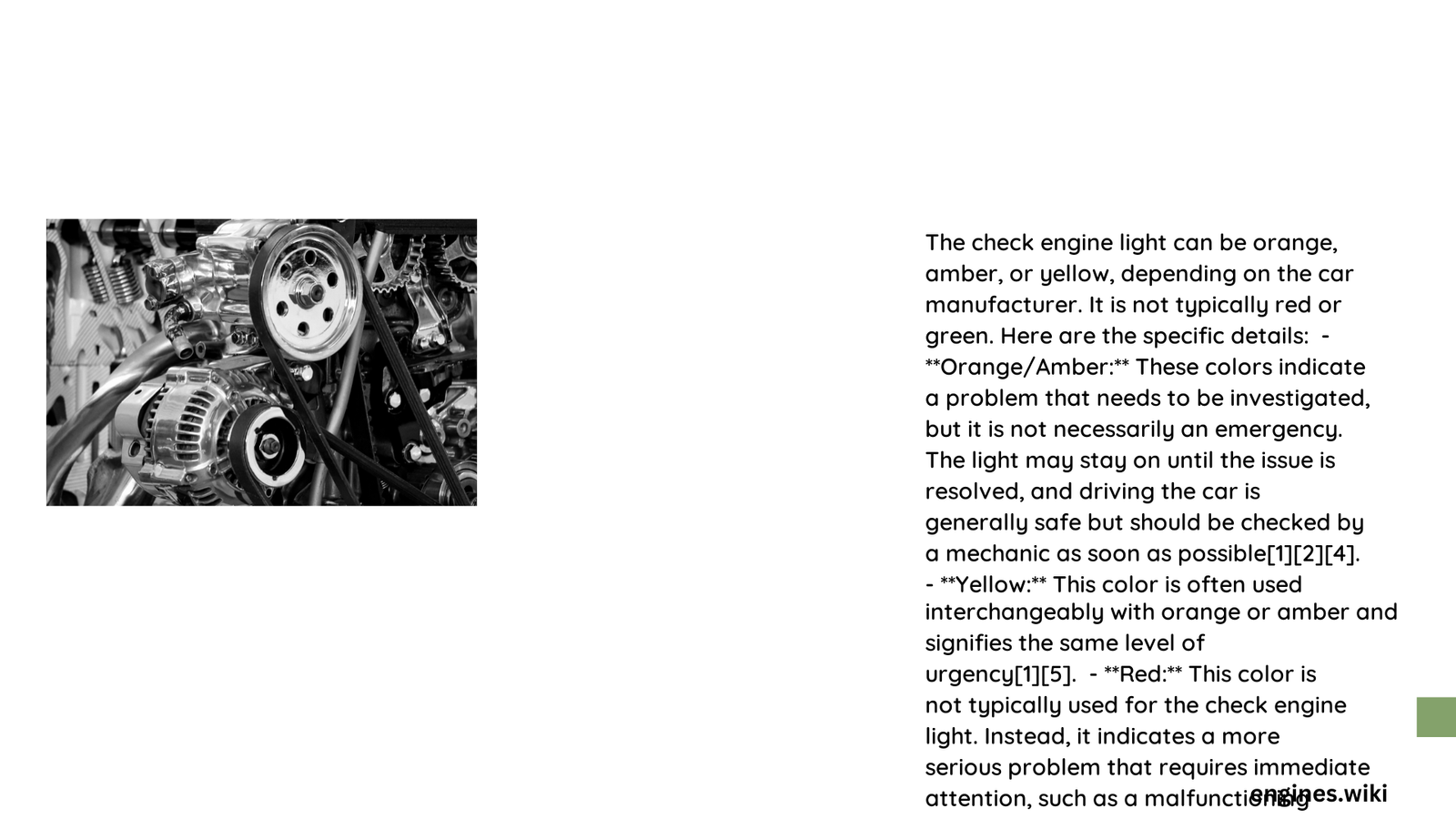Vehicle dashboard warning lights can be complex and confusing, especially the check engine light. Understanding the color variations is crucial for preventing potential engine damage and maintaining your vehicle’s performance. Different colors of the check engine light – red, yellow, orange, and green – communicate varying levels of urgency and potential mechanical issues that require immediate or scheduled attention.
What Does a Red Check Engine Light Mean?
A red check engine light represents the most critical and urgent warning signal in your vehicle’s diagnostic system. When this light appears, it demands immediate action to prevent potential catastrophic engine damage.
Key Characteristics of Red Check Engine Light
- Highest Severity Level
- Indicates imminent risk of significant mechanical failure
- Requires immediate vehicle inspection and potential stopping
| Severity Level | Color | Recommended Action |
|---|---|---|
| Critical | Red | Stop driving immediately |
| Moderate | Yellow/Orange | Schedule inspection soon |
| Low | Green | Monitor and check at convenience |
Why Does the Yellow Check Engine Light Appear?

The yellow check engine light signals a less critical but still important mechanical issue. Unlike the red light, it suggests scheduling a professional diagnostic assessment within a reasonable timeframe.
Common Triggers for Yellow Check Engine Light
- Loose gas cap
- Oxygen sensor malfunction
- Catalytic converter problems
- Minor emissions system issues
- Spark plug or ignition coil complications
Orange Check Engine Light: What Should You Know?
Often considered synonymous with the yellow light, the orange check engine light represents a moderate warning that requires attention but doesn’t mandate immediate vehicle shutdown.
Potential Orange Light Scenarios
- Reduced fuel efficiency
- Potential emissions system complications
- Early-stage mechanical wear
- Sensor or electrical system irregularities
Green Check Engine Light: Rare but Informative
While less common, a green check engine light typically indicates a system check or diagnostic mode rather than an actual mechanical problem.
Green Light Interpretations
- Vehicle self-diagnostic mode
- Confirmation of system functionality
- Potential manufacturer-specific indication
Diagnostic Steps for Check Engine Light Colors
Immediate Actions
- Red Light: Pull over safely, turn off engine
- Yellow/Orange Light: Schedule professional diagnostic
- Green Light: Continue monitoring, no immediate action required
Professional Diagnostic Recommendations
- Use OBD-II scanner for precise code reading
- Consult certified automotive technician
- Address warnings promptly to prevent escalating damage
Statistical Insights
According to automotive diagnostic studies:
– Approximately 50% of vehicle owners experience dashboard warning lights
– 20% specifically encounter check engine light scenarios
– Prompt diagnostic intervention can reduce repair costs by up to 70%
Technical Considerations
Modern vehicles utilize standardized OBD-II (On-Board Diagnostics) systems, enabling more precise warning mechanisms. These systems generate specific error codes corresponding to different light colors and intensities.
Factors Influencing Light Interpretation
- Vehicle make and model
- Manufacturing year
- Onboard diagnostic system complexity
Preventive Maintenance Tips
- Regular vehicle servicing
- Immediate warning light investigation
- Use professional diagnostic tools
- Maintain comprehensive vehicle maintenance records
Cost-Effective Strategies
- Invest in reliable OBD-II scanner
- Understand basic diagnostic procedures
- Develop proactive maintenance habits
- Build relationship with trusted automotive technician
Final Recommendations
Always prioritize your vehicle’s health by understanding and responding appropriately to check engine light colors. Each color represents a unique communication from your vehicle’s complex diagnostic system.
Reference:
– CarMD Vehicle Health Index
– National Institute for Automotive Service Excellence
– Society of Automotive Engineers
